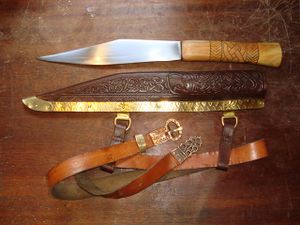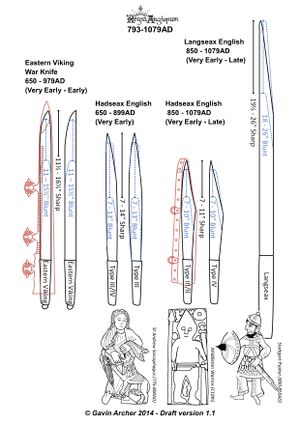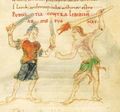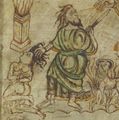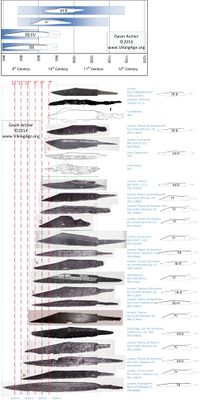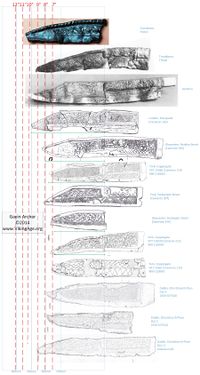Difference between revisions of "Regia:Seax"
m (→Images of Seaxes (C8th to C11th)) |
m |
||
| Line 419: | Line 419: | ||
* Dover, Buckland, grave 145, leather sheath dated to 700-750AD | * Dover, Buckland, grave 145, leather sheath dated to 700-750AD | ||
* London, River Thames nr. Westminster Bridge, metal fittings, late C8th | * London, River Thames nr. Westminster Bridge, metal fittings, late C8th | ||
| + | |||
| + | [[Category:Regia]] | ||
Revision as of 07:05, 6 May 2017
For blades over 14" in length see Langseax
For blades under 7" in length see Knives
Contents
Seaxes
The short seax is also known as a Scramasax, a Hadseax or just a Sax. The term Scramasax comes from Gregory of Tours writing in 575AD, who speaks of "boys with strong knives (cultris validis), which they commonly call scramasaxes (scramasaxos)." in his History of the Franks (IV, 52). It is not known if this name continued in use into the Viking Age.
It is not uncommon for burials in the Viking age to contain more than one knife. It is likely that small heavy seaxes were in use up until the end of the C10th but that as a weapon it possibly really belongs to the pre-Viking period.
Although primarily an everyday tool, in battle it could be used to finish off a felled opponent, and in the case of some ceorls, a mid to large sized scramaseaxe could have taken the place of a sword. Although it contained much the same amount of iron to make as a sword, the scramaseaxe was an easier weapon to make with only one sharp edge and a thick reverse edge. Examples found have both just plain iron blades or pattern welded ones as well as inlaid blades.
Seaxes were also almost certainly just everyday tools: butchery knives, woodworking tools, eating knife, etc.. Most blades were broad, heavy and with an angled back sloping in a straight line towards the point and this is the typical Saxon style.
The Scandinavian style had a more curving back and the Frankish style a more curving blade. Blades were often inlaid with gold, silver, copper or bronze wire beaten into fine channels carved into the iron blade. The grip was of wood, bone or antler and was sometimes carved or decorated. The hilt was usually without a pommel or crossguard, whilst the tang went all the way through the smaller seax handles and was clenched over at the end of the grip.
Scramseaxes were always carried in a sheath of folded leather sewn down the blunt side of the blade, which was often decorated. It is unlikely that a small scramaseax could kill a heavily padded or mailed man, probably just serving to irritate him. It's main employment was probably as an eating and all-purpose 'pocket' knife. The blunt reverse edge of the seax could be used as a hammer to break bones to extract the marrow, or even hammered through materials via it's blunt back as a sharp wedge. It also gives a lot of strength to the whole knife.
Officer Rulings
Please note that there is a change to the rulings for this item from the 1st January 2016.
Authenticity Officer
New Ruling from 1st Jan 2016
For events after 900AD blunt combat hadseax (Scramasax) blade lengths must now be between 18cm and 25cm (7-10”). This replaces the original ruling as stated in the Master-at-Arms Regulations version 3.0 (2005) stating 7-14”.
The evidence from Regia’s core period is that sharp blade lengths vary from between 7-11”. Blunting the point for combat reduces the length by 1”. Longer blades of up to 14” (sharp) or 13” (blunt) of the appropriate blade form are allowed for events before 900AD.
Seaxs from the Viking Age never have metal fittings unlike those from the earlier pagan Anglo-Saxon period.
Seax handles must not be riveted on.
Master-at-Arms
Blade length 178mm - 355mm (7” - 14”)
NOTES
i) The blade and tang must be made from steel. They must be rust and burr free and must be of good overall construction and condition.
ii) The blade edge must be no less than 2mm and no more than 5mm (1/5”) in thickness. In cross section, the edge may be rounded or round shouldered but must not be square edged. The edges of a weapon must include its cutting surface and any back edges also.
iii) Seaxes with a blade exceeding 200mm (8”) in length must be made entirely of spring steel.
iv) The seax tip should be rounded to no less than an 18mm (11/16”) diameter. (i.e. the diameter of a 1999 5 pence piece). Any angle on the back of the seax that is must be rounded over.
v)The blade should not be parallel-edged (back edge to cutting edge).
vi) The blade should not be parallel-sided.
vii) The blade may have a narrow fuller in one or both sides.
viii) Seaxes may have small ferrules on the hand-grip but must not have a properly developed crossguard or a pommel.
New Ruling from 1st Jan 2016
Before 900AD - Blade length 178mm - 355mm (7” - 14”)
After 900AD - Blade length 178mm - 250mm (7” - 10”)
Military Training Officer
Training Stamps - All new members are classed as trainees and must use shield and a two-handed spear and use a hadseax separately.
Using in 'Armoured Man Melees' - Hadseaxs can only be used as a last resort/finishing off weapon.
Living History Co-ordinator
This is the LHE ruling
Research
Images of Seaxes (C8th to C11th)
- 775-800AD St. Andrew Sarcophagus
- C8th England, Derbyshire, Repton. Stone carving, [CAMERON 2000:p.200] [HINTON 2005: p.105]
- 850-900AD Brussels, Bibliotheque Royale, Lat. 9987. Psychomachia
- C9th Paris, BNF, Lat. 8085 fol.57r. Virtue, armed with a sword and seax, combating a Vice. [BNF]
- C10th Brussels, Bibliotheque Royale, ms. 10066-77 Psychomachia f.112r-139r
- England, Dorset, Cranborne. Silver strap-end [HINTON 2005: p.113]
- Middleton Warrior [BAILEY 1980:pl.14]
- 975-1000AD Cambridge, Corpus Christi College MS23, f.23r.[PARKER]
- 1025-1050AD Paris, Bibliothèque Nationale, MS lat 8824 - seax.jpg [OHLGREN 1992]
- 1076AD Bayeux Tapestry [WILSON 1985:pl.6, 7]
Literature (C9th to C11th)
- Beowulf c.1000AD
- "Grendel's mother; the hard man of conflict then heaved, now that he was enraged, the deadly foe, so that she fell to the floor; she again him quickly gave hand-reward with wrathful grips and clutched him against herself; hen, weary in spirit, he stumbled, the strongest man, warrior on foot, so that he was in a fall; then she bestrode the guest in her hall, and drew her seax, broad and bright-edged; she wished to avenge her son, only offspring;" lines 1538-1547 heorot.dk
- "Then again the king himself gathered his wits, drew a slaughter-seax bitter and battle-sharp, that he wore on his byrnie;" lines 2702-2704 heorot.dk
- "beside him lies his life-contender sick with seax-wounds" line 2903-2904 heorot.dk
- "Grendel's mother; the hard man of conflict then heaved, now that he was enraged, the deadly foe, so that she fell to the floor; she again him quickly gave hand-reward with wrathful grips and clutched him against herself; hen, weary in spirit, he stumbled, the strongest man, warrior on foot, so that he was in a fall; then she bestrode the guest in her hall, and drew her seax, broad and bright-edged; she wished to avenge her son, only offspring;" lines 1538-1547 heorot.dk
English Seax Blades (C9th to C11th)
Out of 128 knives found from Coppergate York, only 1 can be classed as a seax. [CAMERON 2000: p.64-65]
| File:Seax Dimmock Cote.jpg 130x150px |
England, Cambridge, River Cam at Dimmock's Cote
|
| File:Seax Cumwhitton 634.jpg 130x150px |
England, Cumwhitton, Plough Soil
|
| File:Seax Cumwhitton 885.jpg 130x150px |
England, Cumwhitton, Grave 5
|
| File:Seax Sittingbourne.jpg 130x150px |
England, Kent, Sittingbourne
|
England, London
| |
| File:Seax London 1856 Honey Lane.jpg 130x150px |
England, London, Honey Lane
|
| File:Seax London 1879 Park Street.jpg 130x150px |
England, London, Park Street
|
| File:Seax London Princes Street.jpg 130x150px |
England, London, Princes Street
|
| File:Seax London 1859 Thames.jpg 130x150px |
England, London,Thames
|
England, London, Thames
| |
| File:Seax London A9313.jpg 130x150px |
England, London, Thames at Blackfriars
|
| File:Seax London A10721.jpg 130x150px |
England, London, Thames at Brentford
|
| File:Seax London A13935.jpg 130x150px |
England, London, Thames at Brentford
|
| File:Seax London O2136.jpg 130x150px |
England, London, Thames at Brentford
|
| File:Seax London A24399.jpg 130x150px |
England, London, Thames at Fulham
|
| File:Seax London A24909.jpg 130x150px |
England, London, Thames at Fulham
|
English style Seax Sheathes (C9th to C11th)
Seax sheaths are made from substantial leather up to 3mm thick and closed by rivets about 4 to 5cm apart. In England there are 12 finds of Seax sheaths out of a total of 61 [CAMERON 2000: p.64-65]
| File:Sheath Aachen.jpg 130x150px |
Germany, Aachen
|
| File:Sheath Trondheim T5919.jpg 130x150px |
Norway, Trondheim, Sor-Trondelag
|
| File:Sheath Trondheim T5919.jpg 130x150px |
Norway, Trondheim, Sor-Trondelag
|
| File:Sheath Dublin DLS4.jpg 130x150px |
Ireland, Dublin, Christchurch Place
|
| File:Sheath Dublin DLS5.jpg 130x150px |
Ireland, Dublin, Christchurch Place
|
| File:Sheath Dublin DLS11.jpg 130x150px |
Ireland, Dublin, Fishamble Street
|
| File:Sheath Gloucester sf.65.jpg 130x150px |
England, Gloucester, 11-17 Southgate Street
|
| File:Sheath Gloucester sf.7.jpg 130x150px |
England, Gloucester, Berkeley Street
|
| File:Sheath Hexham.jpg 130x150px |
England, Hexham
|
| File:Sheath York sf.754.jpg 130x150px |
England, York, Parliament Street
|
| File:Sheath York Coppergate.jpg 130x150px |
England, York, Coppergate
|
| File:Sheath York sf.753.jpg 130x150px |
England, York, Parliament Street
|
| File:Sheath York sf.4332.jpg 130x150px |
England, York
|
| File:Sheath London Trump Street.jpg 130x150px |
England, London, Trump Street
|
| File:Sheath London Cheapside.jpg 130x150px |
England, London, Cheapside
|
A few Seax Sheathes from the C8th
- Dover, Buckland, grave 145, leather sheath dated to 700-750AD
- London, River Thames nr. Westminster Bridge, metal fittings, late C8th
